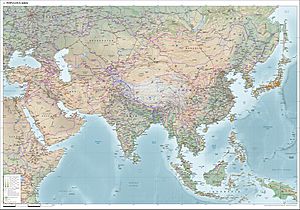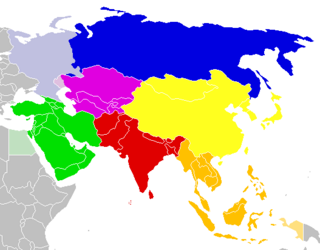Asia facts for kids
 |
|
| Area | 44,579,000 km2 (17,212,000 sq mi) (1st) |
|---|---|
| Population | 4,560,667,108 (2018; 1st) |
| Population density | 100/km2 (260/sq mi) |
| GDP (nominal) | $39 trillion (2022 est; 1st) |
| GDP (PPP) | $72.7 trillion (2022 est; 1st) |
| GDP per capita | $8,890 (2022 est; 4th) |
| Religions |
|
| Demonym | Asian |
| Countries | 49 UN members 1 UN observer 5 other states |
| Dependencies | |
| Non-UN states | |
| Languages | List of languages |
| Time zones | UTC+02:00 to UTC+12:00 |
| Internet TLD | .asia |
| Largest cities |
|
| UN M49 code | 142 – Asia001 – World |
Asia is the largest continent in the world by both land area and population. It covers an area of more than 44 million square kilometers, about 30% of Earth's total land area and 8% of Earth's total surface area. The continent, which has long been home to the majority of the human population, was the site of many of the first civilizations. Its 4.7 billion people constitute roughly 60% of the world's population, having more people than all other continents combined.
Asia shares the landmass of Eurasia with Europe and Afro-Eurasia with both Europe and Africa. In general terms, it is bounded on the east by the Pacific Ocean, on the south by the Indian Ocean, and on the north by the Arctic Ocean. The border of Asia with Europe is a historical and cultural construct, as there is no clear physical and geographical separation between them. It is somewhat arbitrary and has moved since its first conception in classical antiquity. The division of Eurasia into two continents reflects East–West cultural, linguistic, and ethnic differences, some of which vary on a spectrum rather than with a sharp dividing line. A commonly accepted division places Asia to the east of the Suez Canal separating it from Africa; and to the east of the Turkish Straits, the Ural Mountains and Ural River, and to the south of the Caucasus Mountains and the Caspian and Black seas, separating it from Europe.
China and India alternated in being the largest economies in the world from 1 to 1,800 CE. China was a major economic power and attracted many to the east, and for many the legendary wealth and prosperity of the ancient culture of India personified Asia, attracting European commerce, exploration and colonialism. The accidental discovery of a trans-Atlantic route from Europe to America by Columbus while in search for a route to India demonstrates this deep fascination. The Silk Road became the main east–west trading route in the Asian hinterlands while the Straits of Malacca stood as a major sea route. Asia has exhibited economic dynamism (particularly East Asia) as well as robust population growth during the 20th century, but overall population growth has since fallen. Asia was the birthplace of most of the world's mainstream religions including Hinduism, Zoroastrianism, Judaism, Jainism, Buddhism, Confucianism, Taoism, Christianity, Islam, Sikhism, as well as many other religions.
Given its size and diversity, the concept of Asia—a name dating back to classical antiquity—may actually have more to do with human geography than physical geography. Asia varies greatly across and within its regions with regard to ethnic groups, cultures, environments, economics, historical ties and government systems. It also has a mix of many different climates ranging from the equatorial south via the hot desert in the Middle East, temperate areas in the east and the continental centre to vast subarctic and polar areas in Siberia.
Contents
Etymology
The term "Asia" is believed to originate in the Bronze Age placename Assuwa (Hittite: 𒀸𒋗𒉿, romanized: aš-šu-wa) which originally referred only to a portion of northwestern Anatolia. According to many Muslims, the term came from Ancient Egypt's Queen Asiya, the adoptive mother of Moses.
The term was later adopted by the Romans, who used it in reference to the province of Asia, located in western Anatolia. One of the first writers to use Asia as a name of the whole continent was Pliny.
Geography

Asia is the largest continent on Earth. It covers 9% of the Earth's total surface area (or 30% of its land area), and has the longest coastline, at 62,800 kilometres (39,022 mi). Asia is generally defined as comprising the eastern four-fifths of Eurasia. It is located to the east of the Suez Canal and the Ural Mountains, and south of the Caucasus Mountains (or the Kuma–Manych Depression) and the Caspian and Black Seas. It is bounded on the east by the Pacific Ocean, on the south by the Indian Ocean and on the north by the Arctic Ocean. Asia is subdivided into 49 countries, five of them (Georgia, Azerbaijan, Russia, Kazakhstan and Turkey) are transcontinental countries lying partly in Europe. Geographically, Russia is partly in Asia, but is considered a European nation, both culturally and politically.
The Gobi Desert is in Mongolia and the Arabian Desert stretches across much of the Middle East. The Yangtze River in China is the longest river in the continent. The Himalayas between Nepal and China is the tallest mountain range in the world. Tropical rainforests stretch across much of southern Asia and coniferous and deciduous forests lie farther north.
-
Mongolian steppe
-
Taman Negara, Peninsular Malaysia
-
Wadi Rum in Jordan
Main regions
There are various approaches to the regional division of Asia. The following subdivision into regions is used, among others, by the UN statistics agency UNSD. This division of Asia into regions by the United Nations is done solely for statistical reasons and does not imply any assumption about political or other affiliations of countries and territories.
- North Asia (Siberia)
- Central Asia (The 'stans)
- Western Asia (The Middle East or Near East and the Caucasus)
- South Asia (Indian subcontinent)
- East Asia (Far East)
- Southeast Asia (East Indies and Indochina)
Climate

Asia has extremely diverse climate features. Climates range from arctic and subarctic in Siberia to tropical in southern India and Southeast Asia. It is moist across southeast sections, and dry across much of the interior. Some of the largest daily temperature ranges on Earth occur in western sections of Asia. The monsoon circulation dominates across southern and eastern sections, due to the presence of the Himalayas forcing the formation of a thermal low which draws in moisture during the summer. Southwestern sections of the continent are hot. Siberia is one of the coldest places in the Northern Hemisphere, and can act as a source of arctic air masses for North America. The most active place on Earth for tropical cyclone activity lies northeast of the Philippines and south of Japan.
Climate change
Climate change is having major impacts on many countries in the continent. The Asian countries of Bangladesh, India, the Philippines, Vietnam, Thailand, Pakistan, China and Sri Lanka are among the 16 countries facing extreme risk from climate change. Some shifts are already occurring. For example, in tropical parts of India with a semi-arid climate, the temperature increased by 0.4 °C between 1901 and 2003.
The ten countries of the Association of Southeast Asian Nations (ASEAN) – Brunei, Cambodia, Indonesia, Laos, Malaysia, Myanmar, the Philippines, Singapore, Thailand, and Vietnam – are among the most vulnerable to the effects of climate change in the world.
Economy
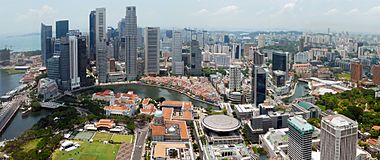
Asia has the largest continental economy by both GDP Nominal and PPP in the world, and is the fastest growing economic region. As of 2018[update], the largest economies in Asia are China, Japan, India, South Korea, Indonesia and Turkey based on GDP in both nominal and PPP. Based on Global Office Locations 2011, Asia dominated the office locations with 4 of the top 5 being in Asia: Hong Kong, Singapore, Tokyo and Seoul. Around 68 percent of international firms have an office in Hong Kong.
It is forecasted that India will overtake Japan in terms of nominal GDP by 2025. By 2027, according to Goldman Sachs, China will have the largest economy in the world. Several trade blocs exist, with the most developed being the Association of Southeast Asian Nations.
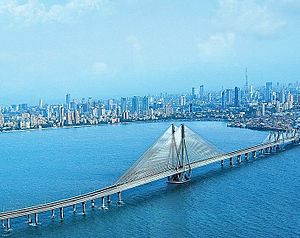
Asia is the largest continent in the world by a considerable margin, and it is rich in natural resources, such as petroleum, forests, fish, water, rice, copper and silver. Manufacturing in Asia has traditionally been strongest in East and Southeast Asia, particularly in China, Taiwan, South Korea, Japan, India, the Philippines, and Singapore. Japan and South Korea continue to dominate in the area of multinational corporations, but increasingly the PRC and India are making significant inroads. Many companies from Europe, North America, South Korea and Japan have operations in Asia's developing countries to take advantage of its abundant supply of cheap labour and relatively developed infrastructure.
Asia has three main financial centers: Hong Kong, Tokyo and Singapore. Due to its large and extremely competitive information technology industry, India has become a major hub for outsourcing.
Trade between Asian countries and countries on other continents is largely carried out on the sea routes that are important for Asia. A far smaller part of the goods traffic runs via South Africa to Europe. A particularly significant part of the Asian goods traffic is carried out across the Pacific towards Los Angeles and Long Beach. Intra-Asian trade, including sea trade, is growing rapidly.
In 2010, Asia had 3.3 million millionaires (people with net worth over US$1 million excluding their homes), slightly below North America with 3.4 million millionaires. At the end of 2011, there were 18,000 Asian people mainly in Southeast Asia, China and Japan who have at least $100 million in disposable assets, while North America with 17,000 people and Western Europe with 14,000 people.
| Rank | Country | GDP (nominal, Peak Year) millions of USD |
Peak Year |
|---|---|---|---|
| 1 | 18,321,197 | 2022 | |
| 2 | 6,272,364 | 2012 | |
| 3 | 3,468,566 | 2022 | |
| 4 | 2,288,428 | 2013 | |
| 5 | 1,973,738 | 2022 | |
| 6 | 1,810,966 | 2021 | |
| 7 | 1,289,429 | 2022 | |
| 8 | 1,010,588 | 2022 | |
| 9 | 957,504 | 2013 | |
| 10 | 828,659 | 2022 |
| Rank | Country | GDP (PPP, Peak Year) millions of USD |
Peak Year |
|---|---|---|---|
| 1 | 30,074,380 | 2022 | |
| 2 | 11,665,486 | 2022 | |
| 3 | 6,109,961 | 2022 | |
| 4 | 4,649,674 | 2022 | |
| 5 | 4,023,501 | 2022 | |
| 6 | 3,320,994 | 2022 | |
| 7 | 2,765,834 | 2022 | |
| 8 | 2,018,260 | 2022 | |
| 9 | 1,661,955 | 2022 | |
| 10 | 1,621,702 | 2022 |
Tourism
With growing Regional Tourism with domination of Chinese visitors, MasterCard has released Global Destination Cities Index 2013 with 10 of 20 are dominated by Asia and Pacific Region Cities and also for the first time a city of a country from Asia (Bangkok) set in the top-ranked with 15.98 million international visitors.
Demographics
| Historical populations | ||
|---|---|---|
| Year | Pop. | ±% p.a. |
| 1500 | 243,000,000 | — |
| 1700 | 436,000,000 | +0.29% |
| 1900 | 947,000,000 | +0.39% |
| 1950 | 1,402,000,000 | +0.79% |
| 1999 | 3,634,000,000 | +1.96% |
| 2016 | 4,462,676,731 | +1.22% |
| Source: "UN report 2004 data" (PDF). The figure for 2018 is provided by the 2019 revision of the World Population Prospects . |
||
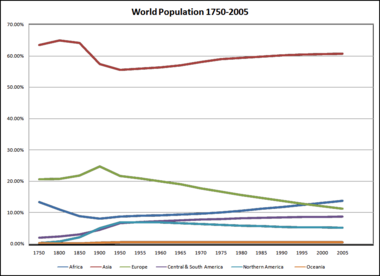
East Asia had by far the strongest overall Human Development Index (HDI) improvement of any region in the world, nearly doubling average HDI attainment over the past 40 years, according to the report's analysis of health, education and income data. China, the second highest achiever in the world in terms of HDI improvement since 1970, is the only country on the "Top 10 Movers" list due to income rather than health or education achievements. Its per capita income increased a stunning 21-fold over the last four decades, also lifting hundreds of millions out of income poverty. Yet it was not among the region's top performers in improving school enrollment and life expectancy.
Nepal, a South Asian country, emerges as one of the world's fastest movers since 1970 mainly due to health and education achievements. Its present life expectancy is 25 years longer than in the 1970s. More than four of every five children of school age in Nepal now attend primary school, compared to just one in five 40 years ago.
Hong Kong ranked highest among the countries grouped on the HDI (number 7 in the world, which is in the "very high human development" category), followed by Singapore (9), Japan (19) and South Korea (22). Afghanistan (155) ranked lowest amongst Asian countries out of the 169 countries assessed.
Languages
Asia is home to several language families and many language isolates. Most Asian countries have more than one language that is natively spoken. For instance, according to Ethnologue, more than 700 languages are spoken in Indonesia, more than 400 languages spoken in India, and more than 100 are spoken in the Philippines. China has many languages and dialects in different provinces.
Religions
Many of the world's major religions have their origins in Asia, including the five most practiced in the world (excluding irreligion), which are Christianity, Islam, Hinduism, Chinese folk religion (classified as Confucianism and Taoism), and Buddhism respectively. Asian mythology is complex and diverse. The story of the Great Flood for example, as presented to Jews in the Hebrew Bible in the narrative of Noah—and later to Christians in the Old Testament, and to Muslims in the Quran—is earliest found in Mesopotamian mythology, in the Enûma Eliš and Epic of Gilgamesh. Hindu mythology similarly tells about an avatar of Vishnu in the form of a fish who warned Manu of a terrible flood. Ancient Chinese mythology also tells of a Great Flood spanning generations, one that required the combined efforts of emperors and divinities to control.
-
Japanese wedding at the Meiji Shrine
-
Bar mitzvah at the Western Wall in Jerusalem
-
Catholic procession of the Black Nazarene in Manila
-
Muslim men praying at the Ortaköy Mosque in Istanbul
Culture
The culture of Asia is a diverse blend of customs and traditions that have been practiced by the various ethnic groups of the continent for centuries. The continent is divided into six geographic sub-regions: Central Asia, East Asia, North Asia, South Asia, Southeast Asia, and West Asia. These regions are defined by their cultural similarities, including common religions, languages, and ethnicities. West Asia, also known as Southwest Asia or the Middle East, has cultural roots in the ancient civilizations of the Fertile Crescent and Mesopotamia, which gave rise to the Persian, Arab, Ottoman empires, as well as the Abrahamic religions of Judaism and Islam. These civilizations, which are located in the Hilly flanks, are among the oldest in the world, with evidence of farming dating back to around 9000 BCE. Despite the challenges posed by the vast size of the continent and the presence of natural barriers such as deserts and mountain ranges, trade and commerce have helped to create a Pan-Asian culture that is shared across the region.
Nobel prizes

The polymath Rabindranath Tagore, a Bengali poet, dramatist, and writer from Santiniketan, now in West Bengal, India, became in 1913 the first Asian Nobel laureate. He won his Nobel Prize in Literature for notable impact his prose works and poetic thought had on English, French, and other national literatures of Europe and the Americas. He is also the writer of the national anthems of Bangladesh and India.
Other Asian writers who won Nobel Prize for literature include Yasunari Kawabata (Japan, 1968), Kenzaburō Ōe (Japan, 1994), Gao Xingjian (China, 2000), Orhan Pamuk (Turkey, 2006), and Mo Yan (China, 2012). Some may consider the American writer, Pearl S. Buck, an honorary Asian Nobel laureate, having spent considerable time in China as the daughter of missionaries, and based many of her novels, namely The Good Earth (1931) and The Mother (1933), as well as the biographies of her parents for their time in China, The Exile and Fighting Angel, all of which earned her the Literature prize in 1938.
Also, Mother Teresa of India and Shirin Ebadi of Iran were awarded the Nobel Peace Prize for their significant and pioneering efforts for democracy and human rights, especially for the rights of women and children. Ebadi is the first Iranian and the first Muslim woman to receive the prize. Another Nobel Peace Prize winner is Aung San Suu Kyi from Burma for her peaceful and non-violent struggle under a military dictatorship in Burma. She is a nonviolent pro-democracy activist and leader of the National League for Democracy in Burma (Myanmar) and a noted prisoner of conscience. She is a Buddhist and was awarded the Nobel Peace Prize in 1991. Chinese dissident Liu Xiaobo was awarded the Nobel Peace Prize for "his long and non-violent struggle for fundamental human rights in China" on 8 October 2010. He is the first Chinese citizen to be awarded a Nobel Prize of any kind while residing in China. In 2014, Kailash Satyarthi from India and Malala Yousafzai from Pakistan were awarded the Nobel Peace Prize "for their struggle against the suppression of children and young people and for the right of all children to education".
Sir C.V. Raman is the first Asian to get a Nobel prize in Sciences. He won the Nobel Prize in Physics "for his work on the scattering of light and for the discovery of the effect named after him".
Japan has won the most Nobel Prizes of any Asian nation with 24 followed by India which has won 13.
Amartya Sen, (born 3 November 1933) is an Indian economist who was awarded the 1998 Nobel Memorial Prize in Economic Sciences for his contributions to welfare economics and social choice theory, and for his interest in the problems of society's poorest members.
Other Asian Nobel Prize winners include Subrahmanyan Chandrasekhar, Abdus Salam, Malala Yousafzai, Robert Aumann, Menachem Begin, Aaron Ciechanover, Avram Hershko, Daniel Kahneman, Shimon Peres, Yitzhak Rabin, Ada Yonath, Yasser Arafat, José Ramos-Horta and Bishop Carlos Filipe Ximenes Belo of Timor Leste, Kim Dae-jung, and 13 Japanese scientists. Most of the said awardees are from Japan and Israel except for Chandrasekhar and Raman (India), Abdus Salam and Malala Yousafzai, (Pakistan), Arafat (Palestinian Territories), Kim (South Korea), and Horta and Belo (Timor Leste).
In 2006, Dr. Muhammad Yunus of Bangladesh was awarded the Nobel Peace Prize for the establishment of Grameen Bank, a community development bank that lends money to poor people, especially women in Bangladesh. Dr. Yunus received his PhD in economics from Vanderbilt University, United States. He is internationally known for the concept of micro credit which allows poor and destitute people with little or no collateral to borrow money. The borrowers typically pay back money within the specified period and the incidence of default is very low.
The Dalai Lama has received approximately eighty-four awards over his spiritual and political career. On 22 June 2006, he became one of only four people ever to be recognized with Honorary Citizenship by the Governor General of Canada. On 28 May 2005, he received the Christmas Humphreys Award from the Buddhist Society in the United Kingdom. Most notable was the Nobel Peace Prize, presented in Oslo, Norway on 10 December 1989.
See also
 In Spanish: Asia para niños
In Spanish: Asia para niños
- Asian cuisine
- Asian Games
- Asia-Pacific
- Asian Para Games
- Asian people
- Eastern world
- Eurasia
- Far East
- East Asia
- Southeast Asia
- South Asia
- Central Asia
- Western Asia
- Middle East
Projects


